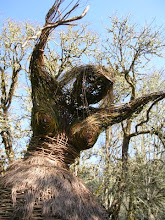I put the fragile slip into an archival sleeve and backer board, and lodged it in the row of things at the back of my desk “for future research.” Now and again I would clean the desk (that doesn’t happen too often, to be sure) and it would pop up again. Undine. Sacking bottoms. Hmmmm.
In the course of events, I acquired as customer a museum whose curator asked me to watch for images of sternwheel steamers that plied the Columbia River. In going through a batch of postcards, I used a loup to read the names on some of the boats. And thus was the mystery of the “Undine” solved! It was one of the fragile-looking but sturdy little sternwheelers that plied the river in the late-19th and early 20th centuries.

That explained the life preservers, and the museum purchased the receipt when I described it. But, I asked the curator – what were sacking bottoms? He had no better guess than I – which was that they might have been pieces of sacking (burlap or sailcloth) used to wrap around cargo. It still didn’t seem likely that the steamboat company would go to the expense of having such items professionally cleaned, though.
(The images here are of the Bailey Gatzert, a steamer that was contemporary with the Undine.)

I did some research in books on maritime and dictionaries, as well as on the Internet, but found no clues.
And several more years passed. Then the other day a bookbinder on one of the mailing lists I subscribe to raised a question about some book boards on an old book he was rebinding – boards that were black and that appeared to be composed of a “fibrous substance impregnated with tar.” A reply offered a link to a description of “tar board” - a millboard “manufactured from old tarred rope, sail cloth, sacking, etc.” Sacking?
That sent me off to explore the Internet again, knowing that many items have been added since my last search. And my first attempt yielded another clue in a description of Georgian Campaign furniture on an antiques site, “elegant Four Post & Tent Bedsteads, with Lath or Sacking bottoms." Ha! So, sacking bottoms were part of a bed, cloth used on the bottom of the bed frame to support the mattress. And finally the use for sacking bottoms on boats was revealed in an article on the “Eye Witness to History” site. Describing the sleeping arrangements on an Erie Canal boat, an historical account notes:
“The way they proceed is as follows - the Settees that go the whole length of the Boat on each side unfold and form a cot bed. The space between this bed and the ceiling is so divided as to make room for two more. The upper berths are merely frames with sacking bottoms, one side of which has two projecting pins, which fit into sockets in the side of the boat. The other side has two cords attached one to each corner. These are suspended from hooks in the ceiling. The bedding is then placed upon them, the space between the berths being barely sufficient for a man to crawl in, and presenting the appearance of so many shelves. Much apprehension is always entertained by passengers when first seeing them, lest the cords should break. Such fears are however groundless. “
Of course I sent the description off to the curator, who probably thought I was nuts for persisting on this topic, but who expressed appreciation for the effort. And one more little “curiosity” itch was scratched for me.




2 comments:
fyi, since you seem mildly interested, "Undine" was also the name of the heroine (or rather, anti-heroine) in Edith Wharton's "The Custom of the Country."
This is a fantastic little story, I totally understand the way one gets hooked by wanting to find out what's behind. And may I add - "Undine" is the German spelling for Ondine, a mythological figure, a beautiful and immortal water nymph.
Post a Comment